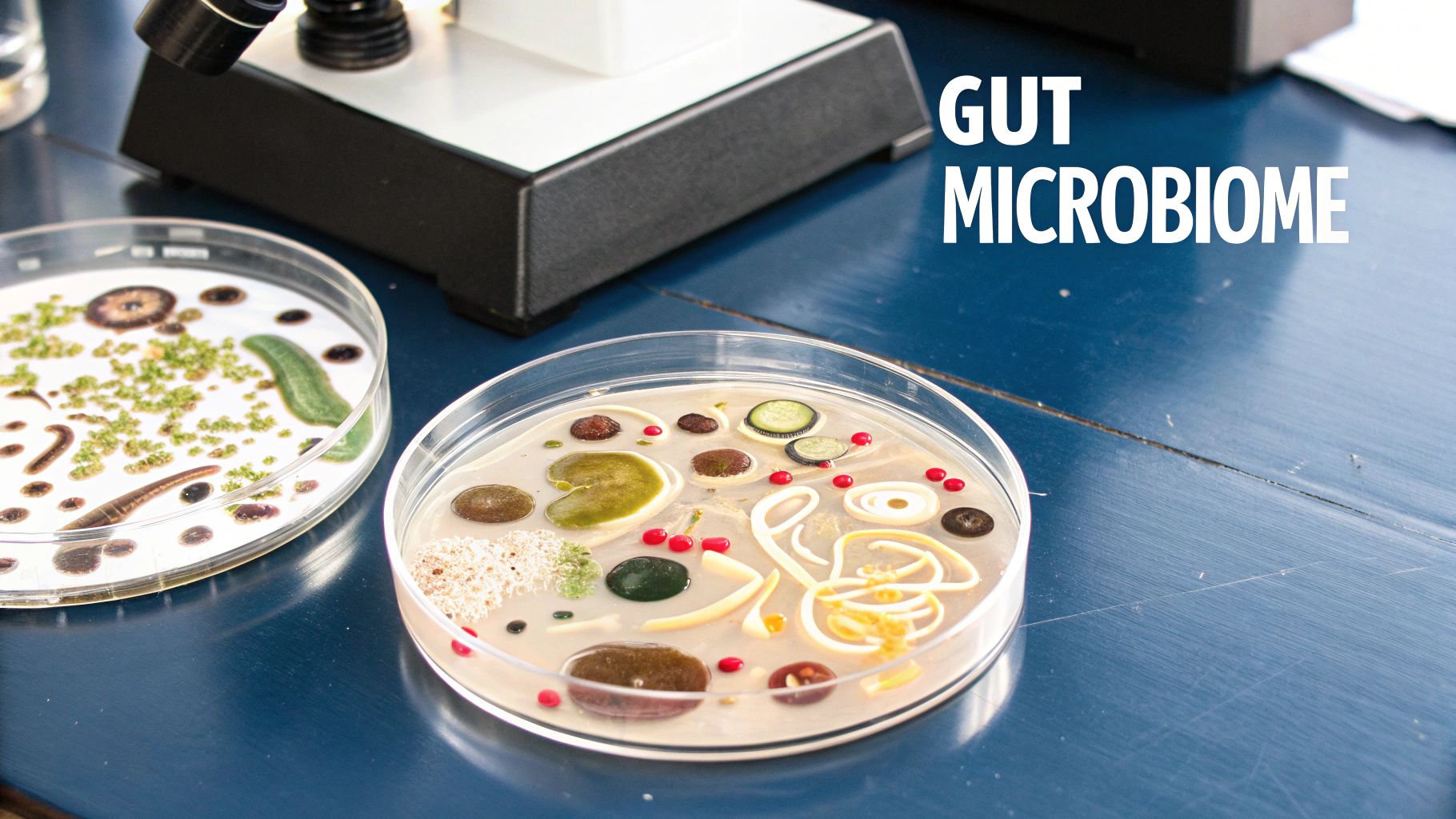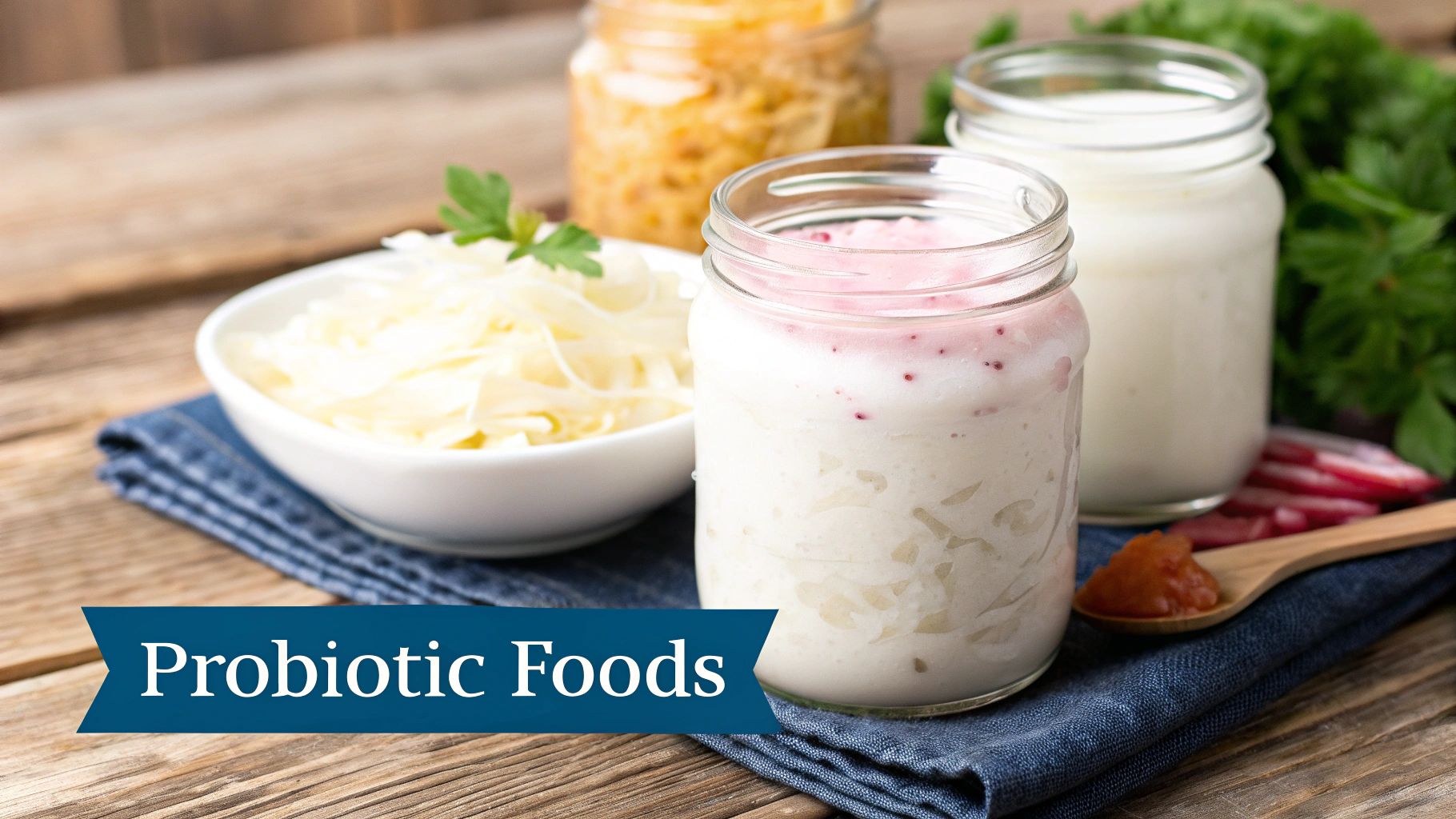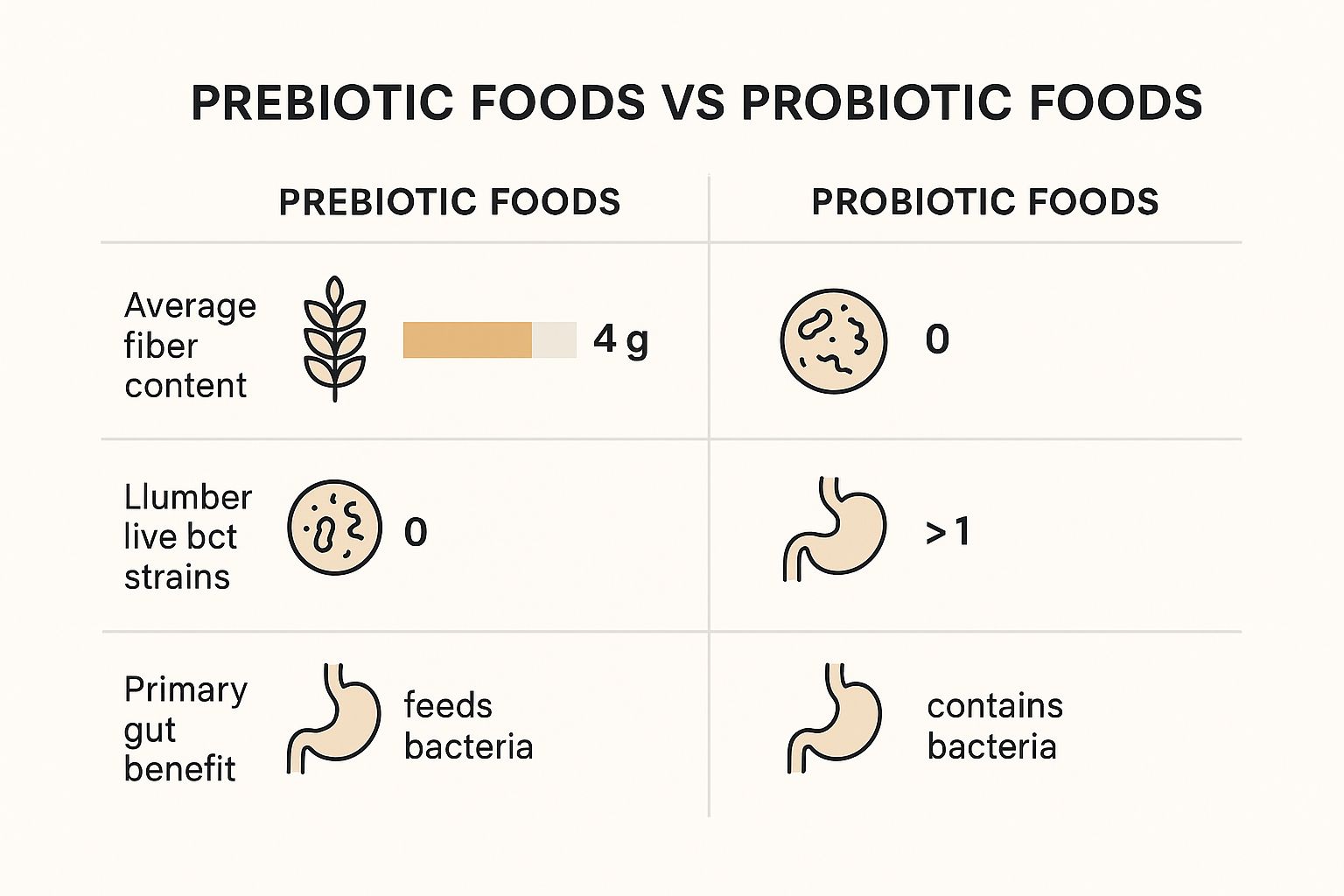How to Improve Gut Health and Finally Feel Your Best
Ever feel like your stomach inflates like a balloon by afternoon? You’re not alone—and it’s not just about what you ate for lunch. That frustrating bloat, unpredictable digestion, and general discomfort can make you feel defeated, but we're here to tell you that finding relief is absolutely possible.
Improving your gut health isn't about a complete, restrictive lifestyle overhaul. The real secret lies in layering small, consistent habits that work for you. In this guide, we'll walk you through simple, powerful steps to nourish your gut, reduce bloating, and get back to feeling like yourself. Let's do this together.
Quick Wins for a Happier Gut Today

When your gut is out of whack, it can feel overwhelming. So, let's start with your starting line—a collection of easy wins you can put into practice immediately. You don't need a pantry makeover or a rigid new diet. Instead, we’re focusing on simple, powerful habits that nourish your gut microbiome, which is the community of trillions of microorganisms living in your digestive tract.
Start with Simple Food Swaps
One of the most effective ways to support your gut is by feeding the good bacteria that live there. And what do they love? Fiber. You don't have to overhaul every meal; just start with small upgrades.
-
Swap white bread for whole grain. This simple switch boosts your fiber intake, which helps keep you regular and feeds your beneficial gut microbes.
-
Add a handful of spinach to your smoothie. It’s an effortless way to sneak in extra nutrients and fiber without changing the taste.
-
Sprinkle nuts or seeds on your yogurt or salad. This adds a satisfying crunch along with healthy fats and, you guessed it, more fiber.
A Quick Tip: I used to think I had to eat a giant, boring salad every day. Now, I just focus on adding one more colorful plant to whatever I’m already eating. It’s less pressure and makes a real difference.
Embrace Fermented Foods
Fermented foods are a natural source of probiotics—live beneficial bacteria that help reinforce your gut community. Introducing them into your diet is easier than you might think.
A dollop of plain yogurt on your morning oats or a side of kimchi with your dinner can introduce diverse, helpful bacteria to your system. Remember, you don't need huge portions. A little bit consistently goes a long way and is a foundational step in learning how to improve gut health without relying solely on supplements.
Understanding Your Gut Microbiome

Before we dive deeper, let's talk about the incredible community living inside your gut. It's home to trillions of microorganisms—bacteria, fungi, and viruses—all working together. This is your gut microbiome.
Think of it as a bustling microscopic city inside your digestive tract. This ecosystem is absolutely essential for just about everything your body does. It helps break down food, absorb nutrients, support your immune system, and even influences your mood. When this city is in harmony, you feel great. But when things get out of balance? Dun, dun, dun—unwelcome gas and bloating. Yikes!
Your Gut Is Uniquely Yours
Here's the most important thing to remember: your gut microbiome is as unique as your fingerprint. What works wonders for your best friend might not do a thing for you, and that’s not just a hunch; it's backed by some serious science.
A massive landmark study analyzed over 160,000 gut microbiome samples from people across 68 countries. The findings were crystal clear: gut bacteria diversity varies immensely from person to person and region to region. This is exactly why a one-size-fits-all approach to gut health so often falls flat. You can explore the fascinating results of this global gut study to see just how different we all are inside.
So, what does this mean for you? It means your journey to figuring out how to improve gut health is personal. It’s all about listening to your body and discovering what makes your unique microbial city thrive.
The Goal: Diversity and Balance
When we talk about a "healthy gut," we're really talking about two key things: diversity and balance.
-
Diversity: You want a wide variety of different types of microbes. Think of it like a rainforest—a diverse ecosystem is more resilient and can perform a wider range of jobs, like breaking down different kinds of fiber or producing beneficial compounds.
-
Balance (or Symbiosis): It’s also crucial that the "good" bacteria outnumber the "bad" ones. An imbalance, known as dysbiosis, is often at the root of many digestive issues.
This imbalance can happen for a ton of reasons—stress, a round of antibiotics, or a diet low in fiber and high in processed foods. When the gut lining becomes compromised, it can sometimes lead to increased intestinal permeability. If you're curious about this, our guide on what leaky gut syndrome is and how to heal it naturally offers a deeper look.
From Yuve's Founder, Sam: “For years, I struggled with this myself. I tried every "miracle" diet out there, only to feel more frustrated. It wasn't until I stopped chasing quick fixes and started focusing on nourishing my own unique microbiome with diverse, plant-based foods that I finally found lasting relief.”
Understanding this core concept is empowering. It shifts the focus from following rigid rules to thoughtfully nurturing your own internal ecosystem. With this foundation, you can make smarter, more intuitive choices. You’ve got this.
Feeding Your Gut with Prebiotic Fiber
If you think of probiotics as the good guys living in your gut, then prebiotic fiber is their five-star meal. It’s really that simple. When you feed your beneficial gut bacteria the right stuff, they flourish, multiply, and in return, they keep you feeling fantastic.
The reality is, most of us are falling short on fiber, which means our microscopic gut crew is often left hungry. The good news? Fixing this isn't about choking down cardboard-flavored health food. It's about knowing which foods are packed with prebiotics and learning how to sneak them into the meals you already enjoy.
Soluble vs. Insoluble Fiber: What’s the Difference?
When we talk about fiber, it’s not a single entity. There are two main players here, and while both are crucial for a happy digestive system, they have very different jobs. Understanding how each type of fiber works can help you make smarter food choices. Both are essential, but they support your gut in unique ways.
Soluble vs Insoluble Fiber
|
Fiber Type |
Top Food Sources |
Primary Gut Benefit |
|---|---|---|
|
Soluble Fiber |
Oats, apples, beans, carrots, citrus fruits |
Dissolves into a gel, slowing digestion to help you feel full and manage blood sugar. |
|
Insoluble Fiber |
Whole grains, nuts, cauliflower, green beans, potatoes |
Acts as "roughage," adding bulk to stool and promoting regularity. |
Don't get too caught up in tracking them separately. A diet that's colorful and full of a wide variety of plants will naturally provide a healthy balance of both.
This infographic really helps to visualize how prebiotics and probiotics team up.

As you can see, prebiotics are the fuel (fiber), while probiotics are the actual live bacteria. You need both for a thriving gut ecosystem.
Simple Ways to Boost Your Fiber Intake
I get it—the advice to "eat more fiber" can sound intimidating, especially if you're worried about turning into a bloated balloon. The trick is to start low and go slow. Your gut microbes need a little time to adjust to the delicious new buffet you're sending their way.
A Little Personal Advice: I learned this the hard way. When I first got serious about gut health, I tried to pack in as much fiber as possible all at once. The bloating was intense! I quickly realized that adding just one new high-fiber food every couple of days was the way to go. It let my system adapt and made the whole process sustainable.
Here are a few easy, bloat-free ways to get started:
-
Toss a tablespoon of chia seeds or ground flaxseeds into your morning oatmeal or smoothie.
-
Mix a half-cup of black beans or chickpeas into a salad or soup.
-
Swap out your usual afternoon snack for an apple with the skin on.
-
Switch from white rice to quinoa or brown rice for one or two dinners a week.
The science behind prebiotic fiber is so compelling that its role in wellness is getting a lot of attention. You can even discover more insights about gut health trends to see what the future holds for nutrition.
On days when life gets in the way and hitting your fiber goals through food feels impossible, a supplement can be a great backup. Our delicious and easy-to-take prebiotic fiber gummies can help bridge the gap, ensuring your gut buddies are always well-fed.
Bring in the Good Guys: Probiotics and Fermented Foods

If prebiotic fiber is the food for your existing gut allies, think of probiotics as calling in fresh reinforcements. You're actively introducing new, beneficial bacteria to the team, which helps diversify and strengthen your entire internal ecosystem. It's a powerful one-two punch for anyone serious about figuring out how to improve gut health.
The good news is, you don’t have to look far to find them. Probiotics are naturally packed into delicious fermented foods that cultures around the world have relied on for centuries. We're talking about tangy yogurt, spicy kimchi, creamy kefir, and crisp sauerkraut. These aren't just tasty additions to a meal; they're a time-tested way to keep your digestion humming along smoothly.
Fermented Foods: The Original Probiotic Source
For most people, starting with fermented foods is the best way to go. They offer a whole community of different bacterial strains and come bundled with all the other nutrients from the food itself. A common mistake is thinking you need to eat huge portions. Not at all. When it comes to gut health, consistency is always more important than quantity.
Here are some ridiculously simple ways to work them into your diet:
-
Plain Yogurt or Kefir: Swirl a few spoonfuls into your morning smoothie. Just be sure to check the label for “live and active cultures”—that’s how you know you're getting the good stuff.
-
Sauerkraut or Kimchi: A small forkful makes a fantastic, zesty side for eggs, tacos, or grain bowls. It adds an incredible pop of flavor along with a dose of beneficial microbes.
-
Miso: This fermented soybean paste is amazing when whisked into salad dressings or marinades for a deep, savory punch.
Finding Your Way Through the Probiotic Supplement Aisle
Sometimes, a more focused approach is needed, and that’s where supplements can be a real help. They deliver specific, well-researched bacterial strains in concentrations you just can't get from food alone. But I'll be the first to admit, walking down that supplement aisle can be completely overwhelming.
The digestive health market is absolutely booming—you can read the full analysis on the growing gut health market to get a sense of the trends. This explosion means more choices for us, but also a lot more noise to filter through.
To make it easier, here's what to look for:
-
CFU Count: This stands for "Colony Forming Units" and indicates how many live bacteria are in each dose. A massive number isn't always better; the specific strains included are far more important.
-
Strain Diversity: A good supplement will contain multiple strains, often from the Lactobacillus and Bifidobacterium families. Different strains have different jobs in the gut.
-
Delivery System: Look for capsules designed to be acid-resistant. This helps protect the good bacteria from your stomach acid, ensuring they arrive alive in your intestines where they can get to work.
Science Corner: Probiotics vs. Digestive Enzymes
It’s incredibly easy to mix these two up, but they do completely different things. Probiotics are the live bacteria that become part of your gut ecosystem. Digestive enzymes, on the other hand, are proteins that act like tiny scissors, helping you break down specific components of your food like fats, carbs, and proteins.
For example, if dairy gives you trouble, it might not be an imbalanced microbiome but a lack of the lactase enzyme. In that case, an enzyme supplement could be a game-changer. It's all about giving your body the right tool for the job.
Lifestyle Habits That Nurture Your Gut
https://www.youtube.com/embed/x6fYqEjG-Nc
While food is a huge piece of the puzzle, understanding how to improve gut health goes way beyond what’s on your plate. Your daily habits—the way you move, sleep, and handle stress—create the entire environment where your gut microbes live. If that environment is constantly in turmoil, it’s almost impossible for them to thrive.
Think of it this way: you can eat all the kale and kimchi in the world, but if you’re chronically stressed and barely sleeping, it’s like trying to grow a beautiful garden in the middle of a hurricane. We have to calm the storm first.
Tame the Stress Response
Ever felt nauseous before a big presentation or had your stomach in knots during a stressful week? That’s the gut-brain connection in action, and it is incredibly real. When you’re stressed, your body pumps out hormones like cortisol that put your entire system on high alert.
This "fight or flight" mode pulls resources away from any process it deems non-essential for immediate survival—and unfortunately, digestion is one of them. This can slow down how food moves through your stomach and intestines, leading to that dreaded bloating and discomfort.
Sam’s Story: “For years, I blamed certain foods for my digestive issues, but the real culprit was my high-stress job. It wasn’t until I started a simple 5-minute morning meditation practice that I noticed a real shift. My stomach just felt… calmer. It proved to me that managing my mind was just as important as managing my meals.”
You don't need a silent retreat to manage stress. Simple practices can make a world of difference:
-
Mindful Moments: Take three deep, slow belly breaths before each meal. This simple act can help switch your body from a stressed state to a "rest and digest" state.
-
Gentle Movement: A quiet walk outside or a few gentle yoga stretches can help lower those cortisol levels.
-
Set Boundaries: It’s okay to say no. Protecting your peace is one of the kindest things you can do for your gut.
Prioritize Quality Sleep
Sleep is your body's master reset button. It’s when your cells repair themselves, your brain organizes memories, and your gut finally gets a chance to rest and recalibrate. When you consistently fall short on quality sleep, it can throw your gut microbes out of balance.
Emerging research shows that the diversity of our gut microbiome can be directly influenced by our sleep patterns. Try to aim for 7-9 hours of consistent sleep per night. If that feels impossible, just start by improving your sleep hygiene: a dark, cool, quiet bedroom and a regular bedtime.
Move Your Body Gently
You don't need to run a marathon to support your gut. Moderate and consistent exercise is one of the best things you can do to promote healthy digestion. Movement helps stimulate the muscular contractions that move food and waste through your system.
A simple 15-minute walk after dinner can do wonders for preventing that heavy, bloated feeling. The goal isn't intense workouts; it's about staying active in a way that feels good to you. Integrating healthy fats like olive oil into your diet is also a crucial lifestyle habit. Discover more about the science-backed benefits of olive oil for digestion and see how it supports this process.
Putting It All Together: Your Personalized Gut Health Plan
We’ve covered a lot, from the magic of prebiotic fiber to why a good night’s sleep is non-negotiable. But the best gut health strategy isn't a one-size-fits-all protocol. It’s the one you build for yourself. This is where you shift from learning about gut health to truly becoming the expert on your own body.
Become Your Own Gut Detective
The single most powerful tool you have is simple observation. To get started, try keeping a basic food and symptom journal. I know, it sounds tedious, but the insights you'll gain are priceless. For one week, just jot down:
-
What you ate and when.
-
How you felt afterward: Note any bloating, gas, energy slumps, or mood swings.
-
Other key factors: Your stress levels, sleep quality, and exercise.
After just a week, patterns you never would have noticed will start to jump out. You might discover that the mid-afternoon bloat isn't from your lunch, but from that stressful meeting right after. To make this easier, there are some great comprehensive food tracking app options that can help streamline the process.
Start Small, Be Patient
Once you’ve spotted a potential trigger, the next move is to experiment. But please, don't try to change everything all at once! That's a recipe for feeling overwhelmed.
Instead, pick just one small thing to test. Let’s say you have a hunch that dairy is causing you some grief. Maybe just try switching to lactose-free milk for a week and see how you feel.
A Customer Story: We heard from Jenna who had been dealing with awful evening bloat for years. After journaling, she realized her habit of chugging a huge glass of ice water with her meal was the real culprit. She switched to drinking water between meals instead, and the bloating disappeared. It was that simple.
Jenna's story is the perfect reminder that the solution is often a small tweak, not a massive overhaul. This journey is all about progress, not perfection.
When to Call in Professional Support
While self-discovery is empowering, there are times when you need a co-pilot. If your symptoms are persistent or severe, it's always a good idea to chat with a doctor or a registered dietitian. They can help rule out underlying conditions and offer more structured guidance.
As you build your plan, remember that targeted supplements can play a fantastic supporting role. Our collection of vegan digestion supplements is designed to provide that extra help, whether it's an enzyme like lactase to assist with a dairy-filled meal or a probiotic to support your overall balance.
Practical Tips & Quick Wins Checklist
Ready to start feeling better? Here are your key takeaways:
-
Eat the Rainbow: Add one more colorful plant to your meals each day.
-
Start Fermenting: Add a spoonful of yogurt, kefir, or sauerkraut to your daily routine.
-
Move Gently: Take a 15-minute walk after your biggest meal of the day.
-
Breathe Before You Eat: Take three deep belly breaths before your meal to activate "rest and digest" mode.
-
Prioritize Sleep: Aim for 7-9 hours of quality sleep per night.
-
Stay Curious: Use a simple journal to connect your food and habits to how you feel.
FAQ: Your Top Gut Health Questions
What should I be eating for a healthier gut?
Eat the rainbow! Focus on vibrant fruits and vegetables, whole grains, and legumes. These foods are loaded with prebiotic fiber that your good gut microbes thrive on. Don't forget fermented foods like yogurt (with live cultures), kefir, and sauerkraut for a probiotic boost.
How long until I actually feel a difference?
It's a journey, not a race. You might notice less bloating in just a few days. But for deeper, more lasting changes, you're looking at several weeks of consistent effort. Be patient and kind to yourself!
Can I just take a supplement and be done with it?
I do NOT think this is the right approach. Supplements are helpers, not heroes. They are most effective when they’re part of a bigger, holistic strategy that includes a healthy diet and lifestyle.
How does stress really impact my digestion?
When you're stressed, your body kicks into ‘fight or flight’ mode. This pulls resources away from digestion, slowing everything down and leading to bloating, cramping, and discomfort. Managing stress is just as crucial as managing your diet.
Are you prepared to consistently support your gut health? Yuve offers an accessible way to care for your microbiome with our natural, plant-based supplements. Check out our range of vegan digestion products here. We also invite you to share your experiences with gut health in the comments section below.
